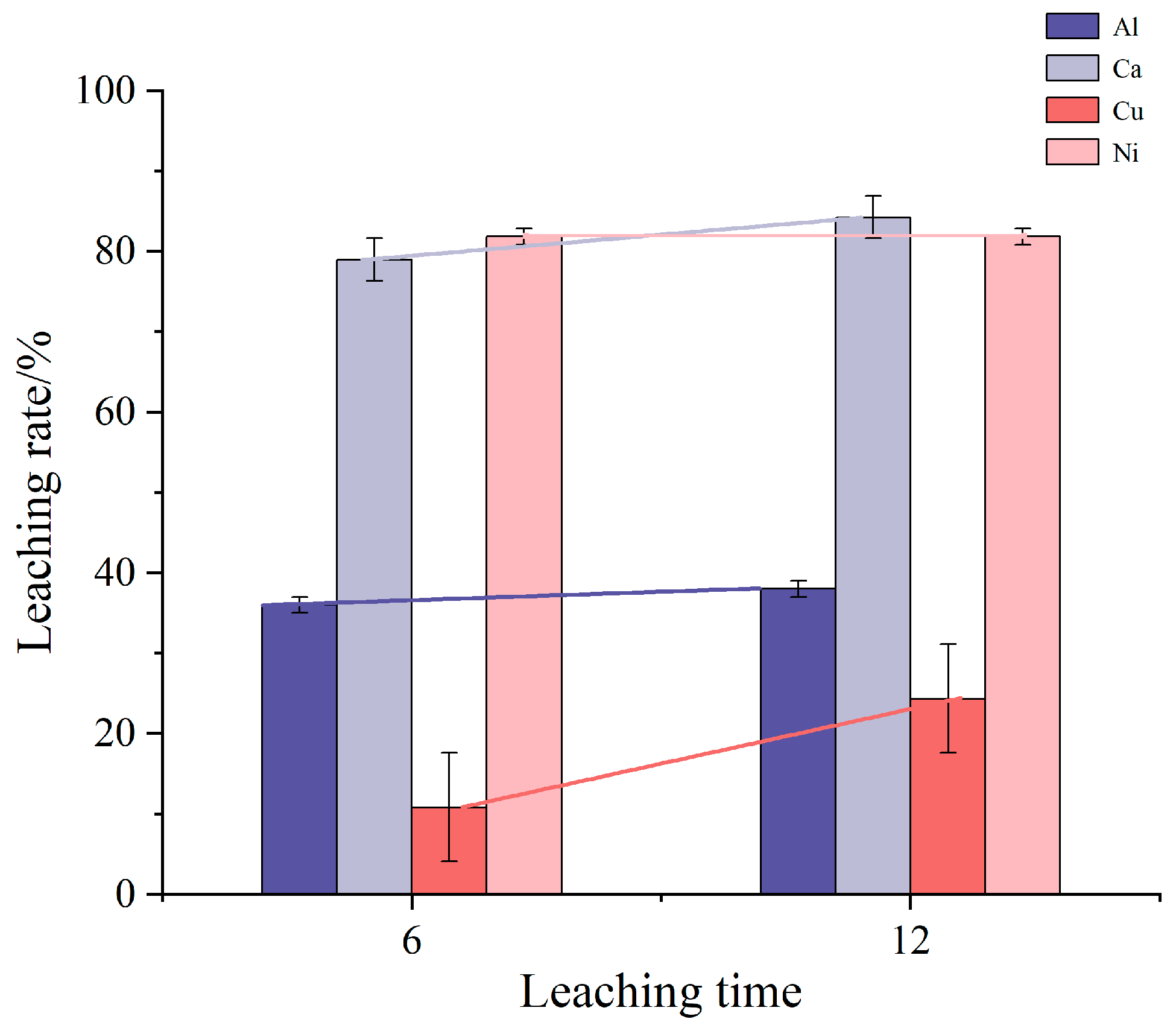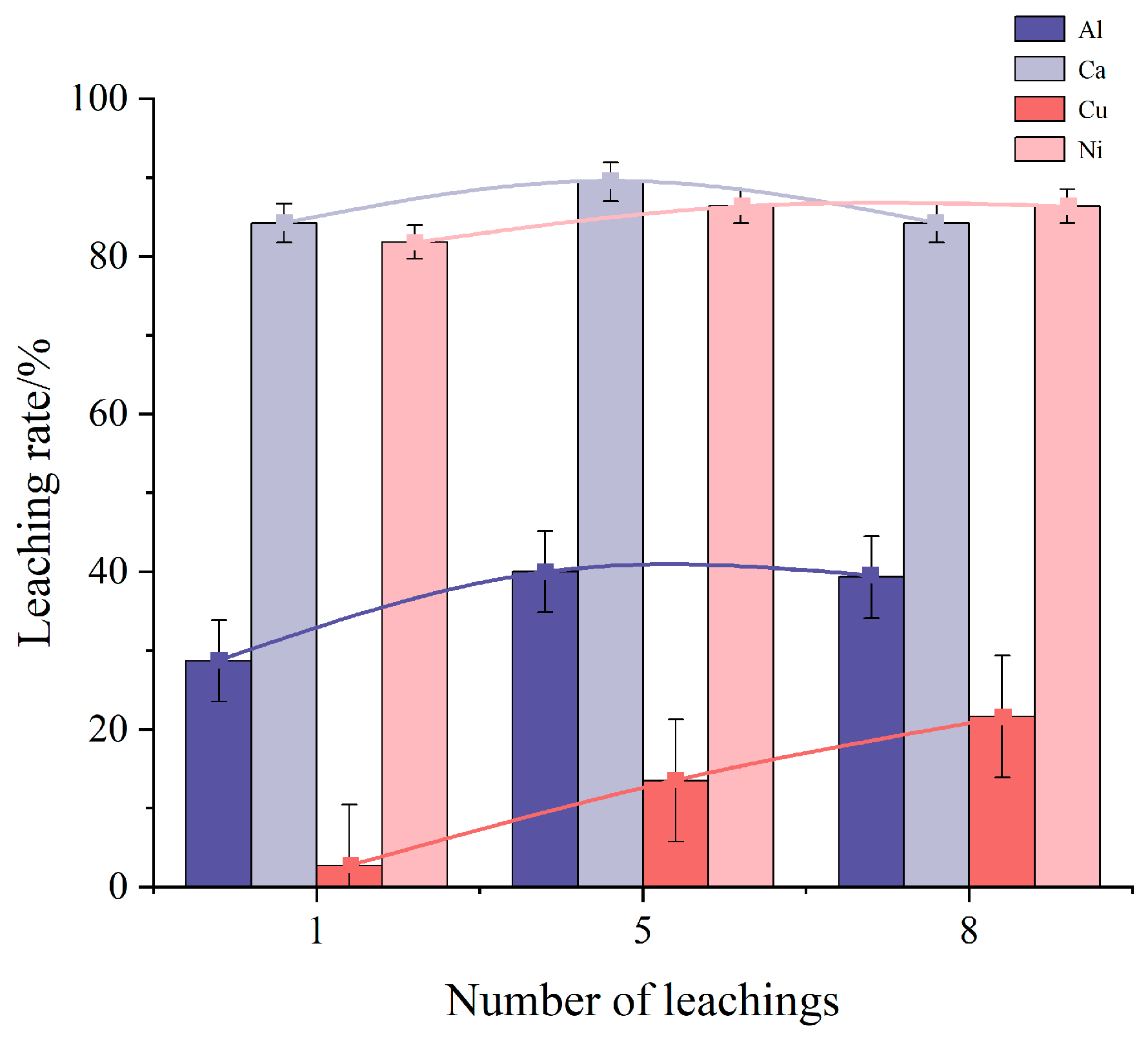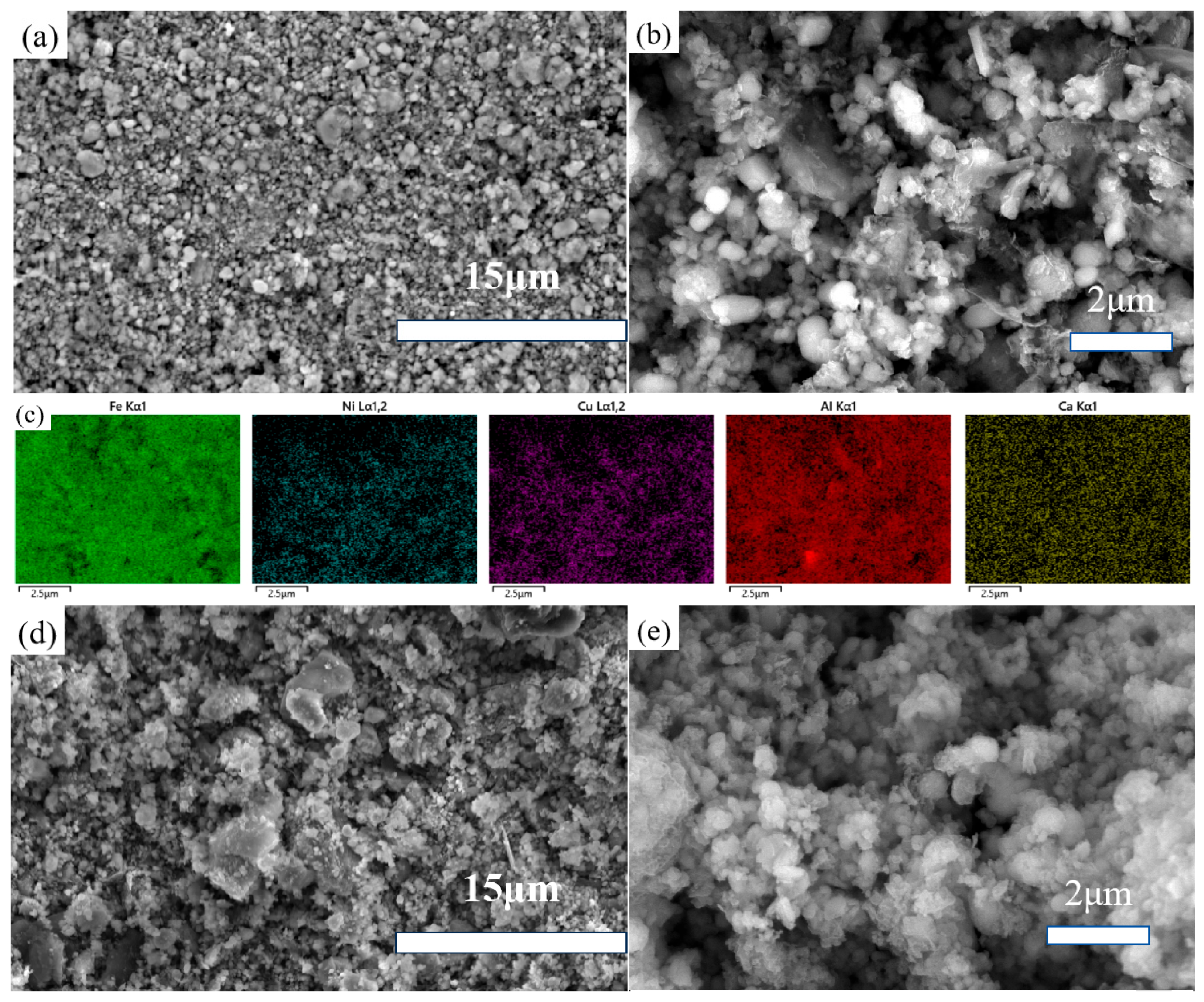Approach towards the Purification Process of FePO4 Recovered from Waste Lithium-Ion Batteries
Abstract
:1. Introduction
2. Experimental Design
3. Results and Discussion
3.1. Dilute Sulfuric Acid Leaching
3.2. Dilute Phosphoric Acid Leaching
3.3. Microstructure Characterization
4. Conclusions
Author Contributions
Funding
Data Availability Statement
Conflicts of Interest
References
- Ning, T.; Lu, B.; Ouyang, X.; Ouyang, H.; Chen, J. Prospect and sustainability prediction of China’s new energy vehicles sales considering temporal and spatial dimensions. J. Clean. Prod. 2024, 468, 142926. [Google Scholar] [CrossRef]
- Xinhua. China’s Installed Capacity of Power Batteries Sees Growth in First 5 Months. Available online: https://english.www.gov.cn/archive/statistics/202406/16/content_WS666eda66c6d0868f4e8e8319.html (accessed on 16 June 2024).
- Yang, T.; Luo, D.; Yu, A.; Chen, Z. Enabling Future Closed-Loop Recycling of Spent Lithium-Ion Batteries: Direct Cathode Regeneration. Adv. Mater. 2023, 35, 2203218. [Google Scholar] [CrossRef]
- Yang, J.; Zhou, K.; Gong, R.; Meng, Q.; Zhang, Y.; Dong, P. Direct regeneration of spent LiFePO4 materials via a green and economical one-step hydrothermal process. J. Environ. Manag. 2023, 348, 119384. [Google Scholar] [CrossRef]
- Larouche, F.; Tedjar, F.; Amouzegar, K.; Houlachi, G.; Bouchard, P.; Demopoulos, P.G.; Zaghib, K. Progress and Status of Hydrometallurgical and Direct Recycling of Li-Ion Batteries and Beyond. Materials 2020, 13, 801. [Google Scholar] [CrossRef] [PubMed]
- Huang, B.; Pan, Z.; Su, X.; An, L. Recycling of lithium-ion batteries: Recent advances and perspectives. J. Power Sources 2018, 399, 274–286. [Google Scholar] [CrossRef]
- Li, H.L.; Chen, Y.Z.; Song, W.J. Electrode material recovery mode and analysis of economic lithium-ion power battery. Adv. New Renew. Energy 2018, 6, 505–511. [Google Scholar]
- Sommerville, R.; Shaw-Stewart, J.; Goodship, V.; Rowson, N.; Kendrick, E. A Review of Physical Processes Used in the Safe Recycling of Lithium Ion Batteries. Sustain. Mater. Technol. 2020, 25, e00197. [Google Scholar] [CrossRef]
- Zhang, G.; Yuan, X.; He, Y.; Wang, H.; Zhang, T.; Xie, W. Recent Advances in Pretreating Technology for Recycling Valuable Metals from Spent Lithium-Ion Batteries. J. Hazard. Mater. 2021, 406, 124332. [Google Scholar] [CrossRef]
- Xiao, J.; Li, J.; Xu, Z. Recycling metals from lithium ion battery by mechanical separation and vacuum metallurgy. J. Hazard. Mater. 2017, 338, 124–131. [Google Scholar] [CrossRef]
- Xin, B.; Zhang, D.; Zhang, X.; Xia, Y.; Wu, F.; Chen, S.; Li, L. Bioleaching mechanism of Co and Li from spent lithium-ion battery by the mixed culture of acidophilic sulfur-oxidizing and iron-oxidizing bacteria. Bioresour. Technol. 2009, 100, 6163–6169. [Google Scholar] [CrossRef]
- Cerrillo-Gonzalez, M.; Villen-Guzman, M.; Vereda-Alonso, C.; Rodriguez-Maroto, J.M.; Paz-Garcia, J.M. Towards Sustainable Lithium-Ion Battery Recycling: Advancements in Circular Hydrometallurgy. Processes 2024, 12, 1485. [Google Scholar] [CrossRef]
- Wang, C.; Yang, H.; Yang, C.; Liu, Y.; Bai, L.; Yang, S. A novel recycling process of LiFePO4 cathodes for spent lithium-ion batteries by deep eutectic solvents. J. Mater. Cycles Waste Manag. 2023, 25, 2077–2086. [Google Scholar] [CrossRef]
- Saleem, U.; Joshi, B.; Bandyopadhyay, S. Hydrometallurgical Routes to Close the Loop of Electric Vehicle (EV) Lithium-Ion Batteries (LIBs) Value Chain: A Review. J. Sustain. Metall. 2023, 9, 950–971. [Google Scholar] [CrossRef]
- Yang, X.; Zhang, Y.; Meng, Q.; Dong, P.; Ning, P.; Li, Q. Recovery of Valuable Metals from Mixed Spent Lithium-Ion Batteries by Multi-Step Directional Precipitation. RSC Adv. 2020, 11, 268–277. [Google Scholar] [CrossRef] [PubMed]
- Yang, Y.; Xu, S.; He, Y. Lithium Recycling and Cathode Material Regeneration from Acid Leach Liquor of Spent Lithium-Ion Battery via Facile Co-Extraction and Co-Precipitation Processes. Waste Manag. 2017, 64, 219–227. [Google Scholar] [CrossRef]
- Song, Y.; Zhao, Z. Recovery of Lithium from Spent Lithium-Ion Batteries Using Precipitation and Electrodialysis Techniques. Sep. Purif. Technol. 2018, 206, 335–342. [Google Scholar] [CrossRef]
- Binnemans, K.; Jones, P.T. The Twelve Principles of Circular Hydrometallurgy. J. Sustain. Metall. 2022, 9, 1–25. [Google Scholar] [CrossRef]
- Liu, P.; Fei, Z.; Zhang, Y.; Dong, P.; Meng, Q.; Yang, X. Efficient oxidation approach for selective recovery of lithium from cathode materials of spent LiFePO4 batteries. JOM 2022, 74, 1934–1944. [Google Scholar] [CrossRef]
- Qiu, X.J.; Zhang, B.C.; Xu, Y.L.; Hu, J.G.; Deng, W.T.; Zou, G.Q.; Hou, H.S.; Yang, Y.; Sun, W.; Hu, Y.H.; et al. Enabling the sustainable recycling of LiFePO4 from spent lithium-ion batteries. Green Chem. 2022, 24, 2506–2515. [Google Scholar] [CrossRef]
- Zeng, S.H. Study on Green Recovery and Regeneration of Lithium Iron Phosphate Cathode Material for Decommissioned Power Battery. Master’s Thesis, Fujian Normal University, Fuzhou, China, 2022. [Google Scholar]
- Kumar, J.; Shen, X.; Li, B.; Liu, H.; Zhao, J. Selective recovery of Li and FePO4 from spent LiFePO4 cathode scraps by organic acids and the properties of the regenerated LiFePO4. Waste Manag. 2020, 113, 32–40. [Google Scholar] [CrossRef]
- Jin, H.; Zhang, J.; Wang, D.; Jing, Q.; Chen, Y.; Wang, C. Facile and efficient recovery of lithium from spent LiFePO4 batteries via air oxidation-water leaching at room temperature. Green Chem. 2021, 24, 152–162. [Google Scholar] [CrossRef]
- Qin, J.; Lu, Y.; Qiao, Z.; Ma, X. A Method for Resource Recovery and Preparation of Battery Grade Iron Phosphate from Iron Phosphate Waste Residue. CN Patent 118387848 A, 26 July 2024. [Google Scholar]
- Sun, L.; Tong, X.; Wu, Y.; Wang, Y.; Hu, Y. A Method for Recycling Lithium Iron Phosphate Extraction Waste to Prepare Battery Grade Iron Phosphate. CN Patent 118221086 A, 21 June 2024. [Google Scholar]
- Fan, E.; Li, L.; Zhang, X.; Bian, Y.; Xue, Q.; Wu, J.; Wu, F.; Chen, R. Selective Recovery of Li and Fe from Spent Lithium-Ion Batteries by an Environmentally Friendly Mechanochemical Approach. ACS Sustain. Chem. Eng. 2018, 6, 11029–11035. [Google Scholar] [CrossRef]
- Liu, Q.; Yu, X.; Xiao, H.; Liu, J.; Qiu, T. Recovery of lithium-extracted tailings from Lithium iron phosphate battery waste and preparation of iron phosphate. Rare Met. Cem. Carbides 2022, 50, 17–23. [Google Scholar]
- Liu, X.; Huang, Z.; Xiao, X.; Xiao, S.; Huang, T.; Zheng, J.; Wu, J. Purification of iron phosphate waste generated zfter recycling of spent batteries. Min. Metall. Eng. 2024, 44, 78–82. [Google Scholar]
- Liu, H.; Mu, J.; Yang, X.; Yan, J.; Wu, S.; Kuang, G. Method for Recovering and Preparing Battery Grade Iron Phosphate from Waste Lithium Iron Phosphate Extraction Residue. CN Patent 115611253 A, 22 March 2022. [Google Scholar]
- Trucill, P.; Lancia, A.; D’Amore, D.; Brancato, B.; Di Natale, F. Selective leaching of precious metals from electrical and electronic equipment through hydrometallurgical methods. Chem. Eng. Trans. 2021, 86, 1039–1044. [Google Scholar]
- Haruna, B.; Luo, Z.; Muhammad, M.A.; Tang, J.; Kuva, J.; Koivula, R.; Bao, H.; Xu, J. Selective Separation of Lithium from Leachate of Spent Lithium-Ion Batteries by Zirconium Phosphate/Polyacrylonitrile Composite: Leaching and Sorption Behavior. Batteries 2024, 10, 254. [Google Scholar] [CrossRef]
- Nguyen, T.T.N.; Lee, M.S.; Nguyen, T.H. Ball Milling Treatment of Black Dross for Selective Dissolution of Alumina in Sodium Hydroxide Leaching. Processes 2018, 6, 29. [Google Scholar] [CrossRef]
- Lv, Y.; Zhao, G.; Shen, C.; Chen, Y.; Fan, Y.; Zhang, G.; Yang, C. Extraction of Vanadium from the Spent Residuum Catalysts by Fenton-like Reaction Followed with Alkaline Leaching. Processes 2023, 11, 2021. [Google Scholar] [CrossRef]
- Chen, B.H.; Guo, Y.; Zhang, X.H.; Yu, G.Q. Deep eutectic solvent-assisted selective extraction of valuable metals from waste lithium-ion batteries. AIChE J. 2024, 70, e18394. [Google Scholar] [CrossRef]
- Qing, J.L.; Wu, X.S.; Zeng, L.; Guan, W.J.; Cao, Z.Y.; Li, Q.G.; Wang, M.Y.; Zhang, G.Q.; Wu, S.X. Novel approach to recycling of valuable metals from spent lithium-ion batteries using hydrometallurgy, focused on preferential extraction of lithium. J. Clean. Prod. 2023, 431, 139645. [Google Scholar] [CrossRef]
- Yang, L.; Feng, Y.; Wang, C.; Fang, D.F.; Yi, G.P.; Gao, Z.; Shao, P.H.; Liu, C.L.; Luo, X.B.; Luo, S.L. Closed-loop regeneration of battery-grade FePO4 from lithium extraction slag of spent Li-ion batteries via phosphoric acid mixture selective leaching. Chem. Eng. J. 2021, 431, 133232. [Google Scholar] [CrossRef]






| Impurity Elements | |||||
|---|---|---|---|---|---|
| Leaching Rate | Al | Cu | Ca | Ni | Experimental Conditions |
| W(%) | 0.961 | 0.039 | 0.092 | 0.020 | acid concentration: 0.2 mol/L; temperature: 120 °C; time: 12 h |
| E(%) | 36.0 | 89.5 | 51.4 | 90.9 | |
| Impurity Elements | |||||
|---|---|---|---|---|---|
| Leaching Rate | Al | Ca | Cu | Ni | Temperature |
| W(%) | 0.822 | 0.041 | 0.019 | 0.008 | 180 °C |
| E(%) | 45.2 | 78.4 | 94.9 | 96.4 | |
| W(%) | 0.524 | 0.029 | 0.012 | 0.006 | 200 °C |
| E(%) | 65.1 | 84.7 | 96.8 | 97.3 | |
| W(%) | 1.057 | 0.051 | 0.039 | 0.021 | 220 °C |
| E(%) | 29.5 | 73.2 | 89.5 | 90.5 | |
| Impurity Elements | |||||
|---|---|---|---|---|---|
| Al | Ca | Cu | Ni | Filling Degree | |
| W(%) | 0.181 | 0.027 | 0.006 | 0.002 | 25% |
| E(%) | 87.9 | 85.8 | 98.4 | 99.1 | |
| W(%) | 0.457 | 0.033 | 0.007 | 0.004 | 50% |
| E(%) | 69.5 | 82.6 | 98.1 | 98.2 | |
| W(%) | 1.110 | 0.061 | 0.043 | 0.023 | 75% |
| E(%) | 26.0 | 67.9 | 88.4 | 89.5 | |
| Element | Fe | Al | Ca | Cu | Ni | Total | |
|---|---|---|---|---|---|---|---|
| Content (%) | 23.04 | 1.50 | 0.19 | 0.37 | 0.22 | ||
| Acid consumption (mol/kg) | Complete dissolution | 12.343 | 0.167 | 0.095 | 0.116 | 0.075 | 12.796 |
| Selective leaching | 0.027 | 0.147 | 0.082 | 0.114 | 0.074 | 0.444 | |
| Price (CNY/kg) | Complete dissolution | 0.420 | 0.006 | 0.003 | 0.004 | 0.003 | 0.436 |
| Selective leaching | 0.005 | 0.028 | 0.016 | 0.022 | 0.014 | 0.085 | |
Disclaimer/Publisher’s Note: The statements, opinions and data contained in all publications are solely those of the individual author(s) and contributor(s) and not of MDPI and/or the editor(s). MDPI and/or the editor(s) disclaim responsibility for any injury to people or property resulting from any ideas, methods, instructions or products referred to in the content. |
© 2024 by the authors. Licensee MDPI, Basel, Switzerland. This article is an open access article distributed under the terms and conditions of the Creative Commons Attribution (CC BY) license (https://creativecommons.org/licenses/by/4.0/).
Share and Cite
Bai, L.; Liu, G.; Fu, Y.; Sun, W.; Zeng, X.; Shao, R.; Ou, H.; Liang, Y.; Yuan, F. Approach towards the Purification Process of FePO4 Recovered from Waste Lithium-Ion Batteries. Processes 2024, 12, 1861. https://doi.org/10.3390/pr12091861
Bai L, Liu G, Fu Y, Sun W, Zeng X, Shao R, Ou H, Liang Y, Yuan F. Approach towards the Purification Process of FePO4 Recovered from Waste Lithium-Ion Batteries. Processes. 2024; 12(9):1861. https://doi.org/10.3390/pr12091861
Chicago/Turabian StyleBai, Liuyang, Guangye Liu, Yufang Fu, Wenbin Sun, Xiaomao Zeng, Rumeng Shao, Huiming Ou, Yunting Liang, and Fangli Yuan. 2024. "Approach towards the Purification Process of FePO4 Recovered from Waste Lithium-Ion Batteries" Processes 12, no. 9: 1861. https://doi.org/10.3390/pr12091861
APA StyleBai, L., Liu, G., Fu, Y., Sun, W., Zeng, X., Shao, R., Ou, H., Liang, Y., & Yuan, F. (2024). Approach towards the Purification Process of FePO4 Recovered from Waste Lithium-Ion Batteries. Processes, 12(9), 1861. https://doi.org/10.3390/pr12091861









